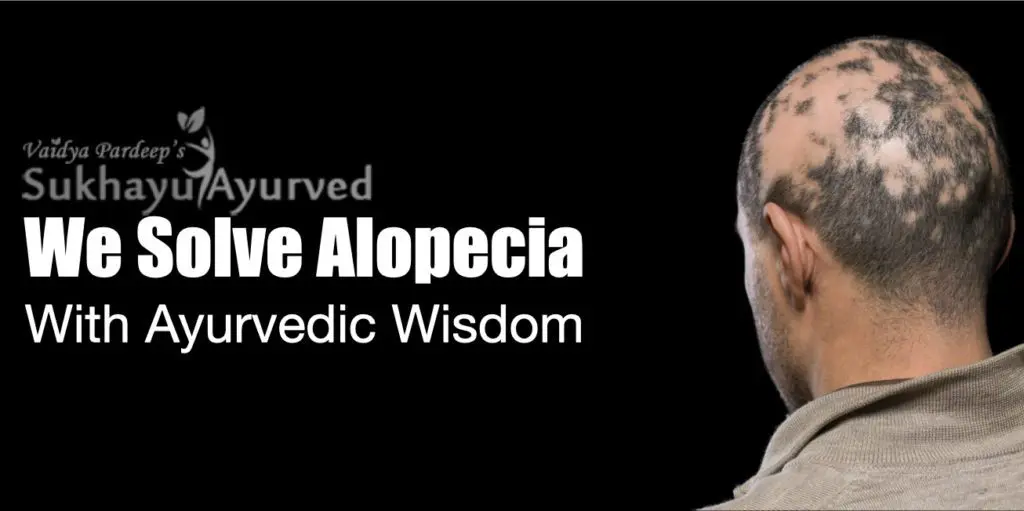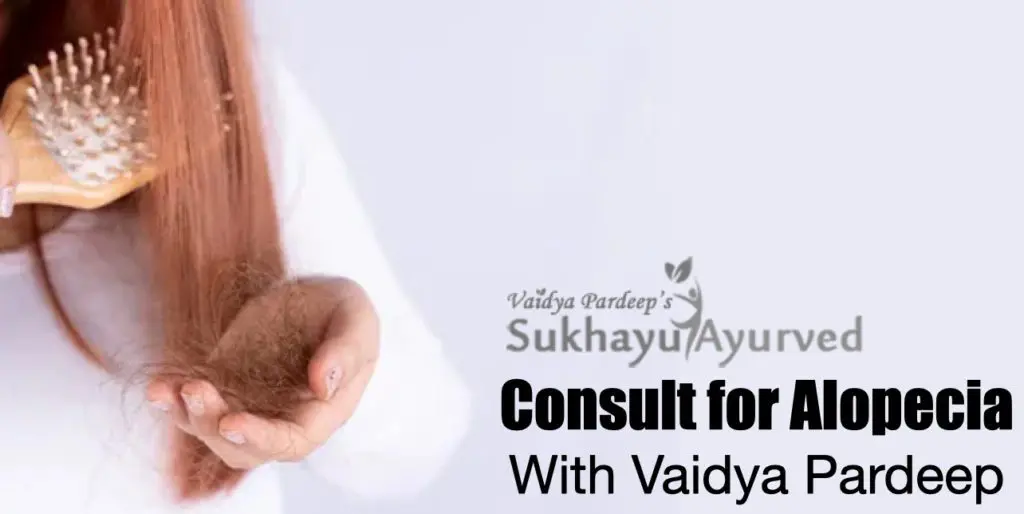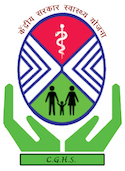Beautiful hair, everyone needs- men as well as women. Because hair adds to the persona. And when you lose hair it changes your presence. It is stress. Stress bothers you regularly and you look at every possibility for treatment of alopecia. When it comes to alopecia ayurvedic treatment. This is the “largest” market with the least results (sorry but true). Because Ayurveda doesn’t recommend to use of any medicines without logic The same is applicable to alopecia ayurvedic treatment too. The alopecia treatment in Ayurveda is based on the reversal of the cause behind the disease. Without working on the cause, it is never possible to defeat a condition like alopecia.
One size doesn’t fit all. In a similar way, every medicine doesn’t help all, either allopathy or Ayurvedic. Therefore the best thing to solve a problem like alopecia with Ayurveda is to find the right diagnosis for the condition. This can help you to get rid of the problem of alopecia with Ayurveda.

Alopecia
Alopecia is a medical condition with hair loss. The area of the body affected by alopecia determines which type it will be, and to what degree the hair loss will be. Alopecia can affect both men and women, although in many cases it may not be noticeable in men because they are generally hairier than women are.
There are different forms of alopecia that cause localized or generalized hair loss in different areas of the body. Totalis, Universalis, and patchy alopecias are types where all the scalp’s hairs fall out. Alopecia areata is another type, in which only some patches on your scalp lose their hairs or there may also be a complete loss of body hairs as well.
Alopecia Areata Alopecia areata is an autoimmune disease that causes the immune system to mistakenly attack its own healthy cells and tissues, including hair follicles on your scalp or other parts of your body. Although this condition affects both genders equally.
It most commonly develops in people aged 10-35 years and those whose family and ancestors have a history of autoimmune diseases such as -Type 1 diabetes, Rheumatoid arthritis (RA).
Let’s discuss the diseases in more detail before discussing the alopecia ayurvedic treatment.
What causes alopecia?
The exact cause of alopecia is unknown. However, scientists believe that it links to one or more external factors such as Inflammation caused by our immune system’s reaction to the body itself. In terms of genetics, alopecia travels from parents to children.
A child with a family history of autoimmune diseases such as Rheumatoid Arthritis or type 1 diabetes.
There are dozens of different types of alopecia; however, the most common form is androgenetic alopecia or alopecia androgénética (male pattern hair loss). This type of hair loss occurs when the hair follicles on the scalp are gradually destroyed due to a change in hormonal levels, which can be triggered by stress.
Alopecia may also occur as a result of other factors, such as skin conditions, infections, hereditary disorders, and nutritional deficiencies.
When we are talking about alopecia ayurvedic treatment, we need to see on the version and vision of Ayurveda too about the causes-
As we will discuss later on, Ayurveda considers the two things when it is about hair loss- Pitta Dosha and Rakta Dhatu.
When there is some disturbance in any of these two, it will certainly lead to the problem of Alopecia. It might be Alopecia androgenic or some complicated condition- these two will disturb for sure.
Pitta dosha is deeply associated with Rakta Dhatu, the pitta resides within Rakta. Therefore these two vitiate at the same time. Because of this, Pitta Prakriti people are prone to alopecia, according to Ayurveda.
Who is at risk?
The following are considered to be at a greater risk of developing alopecia:
- People over 50 years old ·
- Individuals who have experienced significant psychological stress or physical trauma
- People with family members who suffer from alopecia
- Women that take the contraceptive pill.
According to Ayurveda, these are Pitta Prakriti people, who are prone to alopecia. But it never means that if you are Pitta, you will get alopecia. There are higher chances for this.
Pathophysiology of Alopecia?
The basic pathophysiology of alopecia is that the hair growth cycle is disturbed. This leads to the stopping and starting of hair growth, which results in patchy baldness.
Hair Growth Cycle: The phases of a typical hair growth cycle are anagen—the formation phase; catagen—the transition phase; and telogen—the resting phase. During this process, old hairs become weak and fall out while new ones grow back.
Abnormality during this process can lead to abnormal development and behavior of hairs. Damage or loss of stem cells may also affect the formation, normal patterning, and cycling of these cells.
The ayurvedic viewpoint is according to Doshas. The same way viewpoint helps in offering the best alopecia ayurvedic treatment.
It is about Pitta dosha and Rakta Dhatu. But Vata dosha is also involved in the process. Vata is airy and Pitta represents fire. When the airy, Vata enters the space of Pitta, the fire gets stronger and wilder. The destruction increases. This leads to the condition of- the destruction of hair follicles.
What are the types of Alopecia?
As per the pattern of hair loss, alopecia classifies into different types. Here are these in brief.
Alopecia areata:
Alopecia areata is a form of alopecia that affects the hair on your scalp and other parts of your body. In most cases, these areas will begin to bald in round or oval patches. Because the hair follicle remains alive, it is possible for new hairs to grow back even after having lost all visible signs of hair.
Focal non-cicatricial alopecia (chronic telogen effluvium):
Like alopecia areata, it causes patches of baldness with no visible scars. However, complete regrowth is achievable through treatment.
Alopecia Universalis:
It is a rare disease in which all the hair on your scalp, including your eyebrows and eyelashes, falls out. It may develop the following treatment for another condition. Or an underlying condition that affects one’s immune system. The exact cause of this type of alopecia is unknown. There is a group of diseases that play a role, such as Crohn’s disease—an inflammatory bowel disorder—and lupus erythematosus—a chronic autoimmune disease that can affect various parts of the body.
Traction Alopecia:
This non-scarring alopecia happens when hair is pulled too tightly, causing damage to the hair follicles. It most commonly affects African-Americans with tightly braided or dreadlocks hairstyles, but it can also affect anyone who wears a ponytail or cornrows for long periods of time.
Trichotillomania:
Also known as compulsive pulling of one’s own hair, trichotillomania causes noticeable thinning of the scalp and/or eyelashes. In most cases, this condition does not cause complete baldness, but in some individuals, it may lead to a patchy loss over the entire scalp.
Androgenic alopecia
Commonly called male pattern baldness affects up to 70% of males over the age of 50 years. Although genetic factors are very important, other causes can identify in many patients who complain about hair thinning or loss. An increased number of androgen receptors have been found in dermal papilla cells of the male scalp compared to female control subjects. These findings suggest that local production of dihydrotestosterone ( DHT ) may play an important role in the pathogenesis of androgenic alopecia. The classic clue suggesting elevated levels of 5 alpha-reductase type II is the presence of hirsutism or acne conglobata.”
Alopecia ayurvedic treatment helps all types of alopecia.
How common is alopecia?
In developed countries, it affects about 1 in 50 people throughout their lives. Men, male pattern baldness usually begins at puberty/adolescence and becomes more pronounced with age. In women, it occurs predominantly after menopause. It is not present from birth but may appear during childhood or adolescence due to other factors such as skin conditions, infections, or nutritional deficiencies.

Ayurveda about Alopecia?
Ayurveda, the Indian System of Medicine, mentions that there are seven basic tissues (dhatus). The first one mentioned is hair. Ayurvedic texts mention the healthy and normal growth of hair only when the dhatu (the tissue) called ‘Raktha’ (blood) which nourishes it, becomes balanced & proper. It also talks about how unbalanced Raktha leads to various problems like alopecia.
People with alopecia often become very anxious about their condition. This condition happens because of deranged metabolism and using the ayurvedic treatment for alopecia can solve it easily. We can say that alopecia is caused by the deranged pitta dosha which causes vata to enter the pitta region. This causes prativeda (suppression) of Agni (digestive enzymes). As a result, metabolic wastes are not burned up and begin to accumulate in the organism. These wastes cause alopecia.
There are two words that detail the condition of alopecia in Ayurveda.
- Khalitya
- Indralupta
Khalitya as alopecia in Ayurveda
Khalitya means hair loss in Ayurveda. It is classified by Acharya Charaka as a Shiroroga. Khalitya is a Pitta-dominant Tridoshjanya Vyadhi, which means it has a Rakta dosha as well. It’s known as Alopecia or baldness in the scientific literature. It’s often associated with lustful behavior, which is why it’s important to use herbs listed in the chapter on Gowdana Roga (lustful behavior). The Sushruta Samhita lists it as a hereditary disorder.
Khalitya or Hair Loss has many causative factors like Vata, Kapha, and Rakta Doshas. Other causes could be due to faulty use of hair oil, tonics, and other medications; including abnormal diet; excessive sex; trauma; mental disorders; prolonged courses of emetics, purgatives; chronic fevers; vomiting blood, etc.
Indralupta and alopecia
Indralupta comes under scalp disease as well as under skin disease too. This is a condition that shows- loss of hair. Because it talks about the skin as well as scalp, therefore, it links to alopecia areata. In this disease- Pitta and Vata together come to hair follicles. Kapha also associates with these two and obstructs the nutrition of the hair follicles and limits the regrowth of the hair in that region.
This also talks about the “fungal” and “bacterial infections too. Ayurvedic wisdom is beyond the limit. As per Ayurvedic text, the vitiated Rakta in the case of indralupta causes”Keshaad Krimis”. Keshaad is- which resides in the hair.
Therefore, where we have problems with infection, Ayurvedic treatment for alopecia, works in that condition too.
The angle of Ayurveda about alopecia, we have discussed above, while discussing the cause, risk, and pathogenesis of Alopecia. Once we will explore the idea of Ayurveda about alopecia ayurvedic treatment, we need to understand what does Ayurveda says about hair. This will help us to better understand the planning of Ayurvedic treatment for alopecia.
Ayurveda about hair
“Kesha” केश is a Sanskrit word that stands for “hair”. Ayurveda looks at these in a different way-
- Hairs are part of the skin.
- The body hair links to “Asthi-Dhatu”. These develop as a part of the bones, as per Ayurvedic school.
- Because hairs link to the blood, therefore any vitiation of blood or its counter part- Pitta can lead you to “problem with hairs”.
- Hair are not external. The healthy hair comes from inside.
- If you want healthy hair, you need to check the internal system.
Alopecia Ayurvedic Treatment
Ayurveda talks about “wellness” and “ease” in one go. When we are in discomfort due to anything- it means “disease” (Dis-EASE).
Lossing hair and that too all or in patches is the most complicated and bizarre feeling one can have. Then how can Ayurveda not address this condition?
There are many herbs and ayurvedic medicine, which are labeled as – Keshya. Keshya is a set of herbs and ayurvedic medicines which help in improving the quality of hair. These all help in alopecia ayurvedic treatment.
The treatment is carried out with the aim of balancing pitta’s vitiation and pacifying Vata dosha. It takes about three to six months for complete recovery, depending on the duration and severity of alopecia. Treatment involves medicinal formulations, external application (massage), and healthy habits.
First Aid Measures: Ayurveda recommends that people should immediately stop using harsh shampoos or shaving their heads because it will only aggravate the problem. Instead, they should start using natural oils such as coconut oil or castor oil to massage their scalp daily. If itching is experienced then equal quantities of hibiscus flower powder mixed with almond oil can be applied to the itchy area.
How does Alopecia Ayurvedic Treatment help?·
Alopecia ayurvedic treatment helps to cure the internal cause of this condition. Ayurveda believes that alopecia happens because of an internal disorder in pitta, so it focuses on pacifying Vata which has entered into the pitta region. This helps to balance the metabolism and prevent vitiation of pitta.
The herbs used in alopecia ayurvedic treatment help to provide nourishment to the hair roots themselves as well as strengthen them. If hair roots are weak then the hair cannot grow back properly even if alopecia is cured · Digestive enzymes are also helpful for regrowing hair because they assist in proper digestion of the food you eat every day. Special care should be taken during this time period because diet can make or break your health during this time.
According to Ayurveda, the root cause of an unhealthy scalp is an unbalanced Rakta(blood) dhatu. Which leads to various problems like
- dryness or oiliness of scalp,
- itching or burning sensation in the scalp?
- dandruff?
- severe hair fall?
All these are symptoms of a diseased & dysfunctional menstrual cycle. An unhealthy menstrual cycle can be caused by many reasons which include modern-day lifestyle, diet, etc. Other factors that may play a role in hormonal imbalance are emotional stress and imbalances in Vata dosha (one of the three basic body energies).
Panchakarma for Alopecia Ayurvedic treatment
Ayurveda has a very simple & easy to follow solution – Panchakarma. In ancient times, the kings never went to war without first getting themselves treated by panchakarma. This is because this therapy not only boosts health from within but also provides complete detoxification of all our body tissues.
Panchakarma is a comprehensive therapy that consists of various cleansing therapies like Vamana, Virechana, Nasya, and Basti which work on improving digestion and elimination system (Agni).
It’s an ideal way to boost hair growth and prevent Alopecia areata & hair loss as it cleanses the blood inside out which helps in reducing inflammation and thus healing any infections faster.
Because- everybody needs different treatment, therefore you need to consult with Vaidya Pardeep for a better understanding of the case. So that we can advise you of proper treatment.













